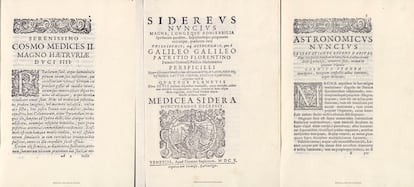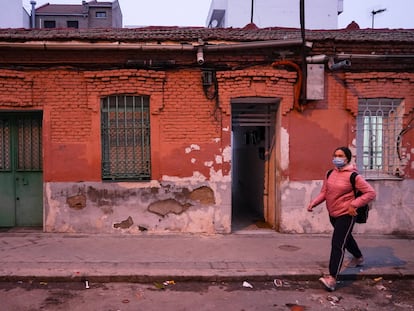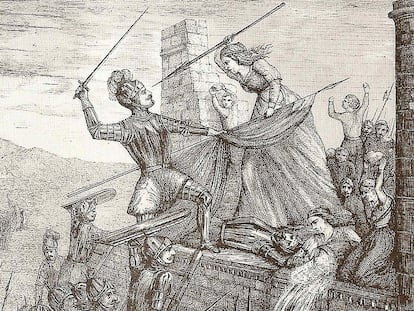Why Spain’s National Library covered up the theft of a Galileo original work
The institution discovered in 2014 that the astronomical treatise ‘Sidereus Nuncius’ had been replaced by a copy but did not report the crime until 2018


For four years, Spain’s National Library concealed the fact that one of the most important works in its extensive collection had been stolen: Sidereus Nuncius, or Sidereal Messenger, an astronomical treatise published by Italian astronomer Galileo Galilei in 1610. The National Police’s historical patrimony department has been investigating the work’s disappearance since 2018. According to specialists who spoke to EL PAÍS, the Latin treatise is worth around €800,000. In the work, Galileo describes the astronomical discoveries he made after building and perfecting a telescope in 1609, including that the moon is mountainous, that Jupiter has four moons and that the Milky Way is made up of separate stars.
It took the National Library four years and four months to report the theft – even though the technical department had known that the original had been replaced by a copy since May 2014, when book restorers discovered it by accident during a program to preserve old books from acid-deterioration called IFADU. But despite this discovery, in these four intervening years, the forged copy of Sidereus Nuncius left by the thief continued to appear in the library’s catalog as the original, according to an investigation by EL PAÍS.
This was not the first time that the Sidereus Nuncius had been stolen from the National Library. The important work, along with 100 other books by astronomers such as Johannes Kepler and Nicolaus Copernicus, were taken from the library in 1987, and recovered two years later by police. As there was nothing different about the treatise, the returned work was thought to be the original.
The copy seemed to us to be too new to be from 1610. The printing and embossing process leaves a mark, and it didn’t have any, it was very clean. We thought it was oddFuensanta Salvador, book restorer
But why did the National Library continue to present the forged copy of Sidereus Nuncius as the original in its catalog and take more than four years to report what happened? To answer this question one has to go back to May 2014, when several restorers from the preservation and conservation department were examining books in the general library. As part of the IFADU program, dozens of books were stacked on tables to be visually examined – including Sidereus Nuncius.
“It was pure chance,” explains Fuensanta Salvador, one of the restorers who was part of the program. “The work has a binding and spine made of parchment. Upon seeing it, we thought that it should be in an acid-free conservation box. The copy seemed to us to be too new to be from 1610. The printing and embossing process leaves a mark, and it didn’t have any, it was very clean. We thought it was odd. We immediately told the technical team.”
The technical team opened an investigation that involved at least three departments and several people, according to Mar Hernández, who was the head of the area at the time. A microscopic examination of the work quickly confirmed the suspicions of the restorers: Sidereus Nuncius was a fake. Despite this, the treatise continued to be listed as the authentic work in the internal catalog of both the National Library and the Digital Hispanic Library. However, the catalog of the exhibition Cosmos, which was held in the library between March and September of 2018, did list the work as a copy. This exhibition, commissioned by José Manuel Sánchez Ron, included 200 works by authors such as Euclid, Claudius Ptolemy, Archimedes and Isaac Newton.

On September 20, 2018 – 52 months after the work was discovered to be a forgery – the head of the National Library, Ana Santos, received an email from British researcher Nick Wilding, warning her that Sidereus Nuncius, which was digitized by the library, was a copy. Wilding, a professor of Georgia State University in the United States, had discovered another forgery of the same work back in 2012. According to Santos, Wilding offered to provide all the information to show that the treatise was not the original. “Of course, I accepted his proposal,” says Santos. “The first thing I asked was why had no one informed me.”
Eight days later, Carlos Solís, a science history researcher at Madrid’s Complutense University, sent a message to the library’s email address for general inquiries that stated: “Galileo’s work Sidereus Nuncius is not in the National Library’s catalog, in its place, there is a copy. Where is the original now?”
On October 3, the National Library replied to his inquiry: “The work you refer to is, as indicated in the library’s catalog, a copy of the 1610 edition.” That same day, Solís replied: “The question is: where is the original that has been substituted now for a copy?” Seven days later, on October 20, 2018, Santos reported to police that Sidereus Nuncius had been stolen. But why did it take more than four years to report such an important robbery? “We thought that we needed to have more information before filing a report,” says Santos, who has headed the National Library since 2013. “We wanted to know when the forged copy arrived, the trajectory of the book, when it disappeared. The investigation had not ended, more information still had to be collected.”
The first thing I asked was why had no one informed meAna Santos, head of the National Library
According to Santos, no one in the library told her that the work had been stolen in 2014 and that she only found out thanks to the email from the British researcher. “The technical team wrote a report [on the theft], without signing it, dated June 7, 2015, but it was not brought to management,” she says.
But Mar Hernández, who was head of the technical team at the time and is now retired, refutes this version of events. According to Hernández, Santos called her in 2018 – two days before the police report was filed – to reprimand her for not informing her of the robbery four years ago. In response, Hernández sent Santos an email two days later that in addition to arguing that the head of the library was indeed told of the situation, pointed out that the issue was discussed in a meeting on problematic books in the library.
In the email, to which EL PAÍS has had access, Hernández tells Santos: “I have always consulted and informed you of everything. You never would have put up with a person appointed by you who you did not completely trust and who did not inform you of everything. After the weekly meeting of the management team, you, José Luis Bueren [the current head of the technical department] and I stayed back to discuss the issue and try and find a solution.” Hernández also has two other emails that support her argument: one sent in 2014 in which she asks Santos to be informed of the situation, and another one from 2016, sent to four people, where she says that she has told Santos about the forged copy.
One day after Santos filed a police report, Solís finally received a response to his inquiry about the whereabouts of the original. The National Library said that the copy of Sidereus Nuncius was a fake, that it was not known what happened to the original and that the case had been brought to the police. Since then, the work now appears in the library catalog as a “copy” instead of the “original” version.
Main suspect
After Sidereus Nuncius was discovered to be a fake in 2014, investigators found out that one of the few people who had consulted the work before it was taken was César Ovidio Gómez Rivero, the man who stole two engraved and illustrated world maps from the 1482 treatise Geography by Ptolemy from the National Library in 2007. This theft highlighted the lack of security at the institution and led Spanish writer Rosa Regàs to resign as its leader. César Antonio Molina, who was culture minister at the time, accused Regàs of not telling him of the theft.
According to police sources, Gómez Rivero consulted Sidereus Nuncius in 2004, three years before stealing the maps from Geography. The thief, who was born in Uruguay, posed as a researcher to access the library’s valuable incunables between 2004 and 2007. The maps were later recovered in New York and Sydney.
Santos says that security at the library has been tightened since she took charge and that it is very difficult to swap an original for a forgery. “It is a failure and a misfortune, but unfortunately robberies happen. The world of forgeries is complicated. More forged copies have been detected in the library. We have not tried to cover up anything,” she says.
English version by Melissa Kitson.
Tu suscripción se está usando en otro dispositivo
¿Quieres añadir otro usuario a tu suscripción?
Si continúas leyendo en este dispositivo, no se podrá leer en el otro.
FlechaTu suscripción se está usando en otro dispositivo y solo puedes acceder a EL PAÍS desde un dispositivo a la vez.
Si quieres compartir tu cuenta, cambia tu suscripción a la modalidad Premium, así podrás añadir otro usuario. Cada uno accederá con su propia cuenta de email, lo que os permitirá personalizar vuestra experiencia en EL PAÍS.
¿Tienes una suscripción de empresa? Accede aquí para contratar más cuentas.
En el caso de no saber quién está usando tu cuenta, te recomendamos cambiar tu contraseña aquí.
Si decides continuar compartiendo tu cuenta, este mensaje se mostrará en tu dispositivo y en el de la otra persona que está usando tu cuenta de forma indefinida, afectando a tu experiencia de lectura. Puedes consultar aquí los términos y condiciones de la suscripción digital.
More information
Últimas noticias
Most viewed
- Sinaloa Cartel war is taking its toll on Los Chapitos
- Oona Chaplin: ‘I told James Cameron that I was living in a treehouse and starting a permaculture project with a friend’
- Reinhard Genzel, Nobel laureate in physics: ‘One-minute videos will never give you the truth’
- Why the price of coffee has skyrocketed: from Brazilian plantations to specialty coffee houses
- Silver prices are going crazy: This is what’s fueling the rally










































